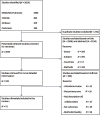The common characteristics and outcomes of multidisciplinary collaboration in primary health care: a systematic literature review
- PMID: 26150765
- PMCID: PMC4491327
- DOI: 10.5334/ijic.1359
The common characteristics and outcomes of multidisciplinary collaboration in primary health care: a systematic literature review
Abstract
Introduction: Research on collaboration in primary care focuses on specific diseases or types of collaboration. We investigate the effects of such collaboration by bringing together the results of scientific studies.
Theory and methods: We conducted a systematic literature review of PubMed, CINAHL, Cochrane and EMBASE. The review was restricted to publications that test outcomes of multidisciplinary collaboration in primary care in high-income countries. A conceptual model is used to structure the analysis.
Results: Fifty-one studies comply with the selection criteria about collaboration in primary care. Approximately half of the 139 outcomes in these studies is non-significant. Studies among older patients, in particular, report non-significant outcomes (p < .05). By contrast, a higher proportion of significant results were found in studies that report on clinical outcomes.
Conclusions and discussion: This review shows a large diversity in the types of collaboration in primary care; and also thus a large proportion of outcomes do not seem to be positively affected by collaboration. Both the characteristics of the structure of the collaboration and the collaboration processes themselves affect the outcomes. More research is necessary to understand the mechanism behind the success of collaboration, especially on the exact nature of collaboration and the context in which collaboration takes place.
Keywords: integrated care; inter-professional relations; multidisciplinary collaboration; outcomes; primary health care.
Figures
Similar articles
-
The Effectiveness of Integrated Care Pathways for Adults and Children in Health Care Settings: A Systematic Review.JBI Libr Syst Rev. 2009;7(3):80-129. doi: 10.11124/01938924-200907030-00001. JBI Libr Syst Rev. 2009. PMID: 27820426
-
How has the impact of 'care pathway technologies' on service integration in stroke care been measured and what is the strength of the evidence to support their effectiveness in this respect?Int J Evid Based Healthc. 2008 Mar;6(1):78-110. doi: 10.1111/j.1744-1609.2007.00098.x. Int J Evid Based Healthc. 2008. PMID: 21631815
-
Multidisciplinary collaboration in primary care: a systematic review.Fam Pract. 2018 Mar 27;35(2):132-141. doi: 10.1093/fampra/cmx085. Fam Pract. 2018. PMID: 28973173
-
How has the impact of 'care pathway technologies' on service integration in stroke care been measured and what is the strength of the evidence to support their effectiveness in this respect?JBI Libr Syst Rev. 2008;6(15):583-632. doi: 10.11124/01938924-200806150-00001. JBI Libr Syst Rev. 2008. PMID: 27819972
-
How can we improve cancer care? A review of interprofessional collaboration models and their use in clinical management.Surg Oncol. 2011 Sep;20(3):146-54. doi: 10.1016/j.suronc.2011.06.004. Epub 2011 Jul 16. Surg Oncol. 2011. PMID: 21763127 Review.
Cited by
-
Interprofessional Collaboration between General Physicians and Emergency Department Teams in Belgium: A Qualitative Study.Int J Integr Care. 2017 Oct 2;17(4):9. doi: 10.5334/ijic.2520. Int J Integr Care. 2017. PMID: 29588632 Free PMC article.
-
An Overview of Reviews on Interprofessional Collaboration in Primary Care: Effectiveness.Int J Integr Care. 2021 Jun 22;21(2):31. doi: 10.5334/ijic.5588. Int J Integr Care. 2021. PMID: 34220395 Free PMC article.
-
Do primary care professionals agree about progress with implementation of primary care teams: results from a cross sectional study.BMC Fam Pract. 2016 Nov 22;17(1):163. doi: 10.1186/s12875-016-0541-9. BMC Fam Pract. 2016. PMID: 27875994 Free PMC article.
-
Improving Multidisciplinary Team Working to Support Integrated Care for People with Frailty Amidst the COVID-19 Pandemic.Int J Integr Care. 2023 Jun 5;23(2):23. doi: 10.5334/ijic.7022. eCollection 2023 Apr-Jun. Int J Integr Care. 2023. PMID: 37303477 Free PMC article.
-
The roles of healthcare professionals in diabetes care: a qualitative study in Norwegian general practice.Scand J Prim Health Care. 2020 Mar;38(1):12-23. doi: 10.1080/02813432.2020.1714145. Epub 2020 Jan 21. Scand J Prim Health Care. 2020. PMID: 31960746 Free PMC article.
References
-
- Xyrichis A, Ream E. Teamwork: a concept analysis. Journal of Advanced Nursing. 2008;61(2):232–41. Available from: http://www.ncbi.nlm.nih.gov/pubmed/18186914. - PubMed
-
- Minkman M, Ahaus K, Fabbricotti I, Nabitz U, Huijsman R. A quality management model for integrated care: results of a Delphi and Concept Mapping study. International Journal for Quality in Health Care. 2009;21(1):66–75. Available from: http://www.ncbi.nlm.nih.gov/pubmed/18945745. - PubMed
-
- Shortell SM, Gillies RR, Anderson DA, Erickson KM, Mitchell JB. Integrating health care delivery. Health Forum Journal. 2000;43(6):35–39. Available from: http://www.ncbi.nlm.nih.gov/pubmed/11186660. - PubMed
-
- Lemieux-Charles L, McGuire WL. What do we know about health care team effectiveness? A review of the literature. Medical Care Research and Review. 2006;63(3):263–300. Available from: http://www.ncbi.nlm.nih.gov/pubmed/16651394. - PubMed
-
- Minkman MMN, Vermeulen RP, Ahaus KJ, Huijsman R. The implementation of integrated care: the empirical validation of the Development Model for Integrated care. BMC Health Services Research. 2011;11:177. Available from: http://www.ncbi.nlm.nih.gov/pubmed/21801428. - PMC - PubMed
LinkOut - more resources
Full Text Sources
Other Literature Sources



